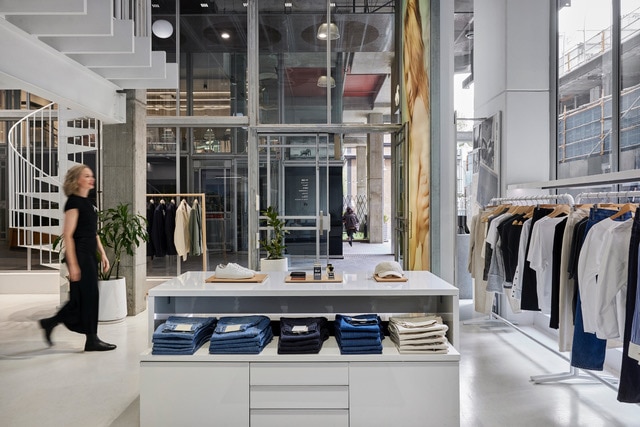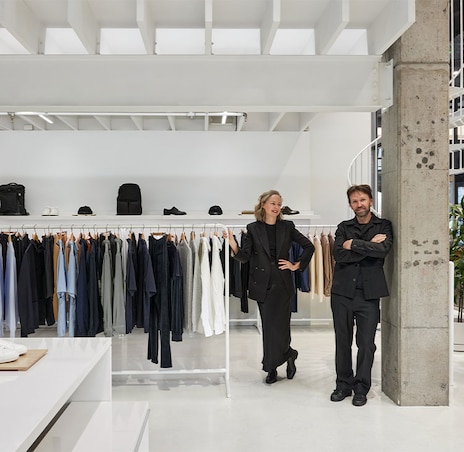1. What was the inspiration behind creating Swensk?
Mats and I had very humble aspirations when we created the idea of Swensk, we wanted to have a smile on our face on Monday mornings and maintain a connection to Sweden.
The business idea was born from the Anholt-GMI Nation Brands Index in 2016 that named Sweden as the number one nation brand. From here we wanted to find a product that embodied the Swedish culture of creating things that last, with understated and functional design.
We had no experience in the fashion retail sector. However, with Scandinavian furniture and architecture internationally celebrated, we saw fashion as a more accessible everyday design product that people could enjoy.
2. What is coming up for you in 2024?
In 2024, we're confronting the changing dynamics of retail due to remote work trends, particularly in CBDs. Our focus is on adapting to this shift and exploring new opportunities, including potential expansions like 'Swensk Flagship' and 'Swensk Sydney.' Additionally, we are considering innovative concepts like 'Swensk after-hours' shopping.
Stay tuned for updates, including plans for a lifestyle adventure in Sweden with the family!

3. Electrolux is a Swedish brand. What about Swedish cuisine or ways of living do you admire or feel inspired by?
With Mats being Swedish and my time living in Sweden, our lifestyle blends Australian and Swedish influences. Our home aesthetic reflects this mix with minimalism, Scandinavian design, and traditional Swedish elements like printed fabrics. And of course, our appliances are Electrolux.
We enjoy contemporary Swedish food when we visit Sweden, but our weekly dinners are the classic Swedish meals like meatballs with pickled cucumber. Our boy’s favourite dinner is Mats’ pancakes, a meal his mother made every Friday for him as a boy growing up in Sweden.
4. Electrolux has a Better Living 2030 program that encourages people to employ more sustainable approaches to fashion and laundry. What are some tips you can share on shopping, wearing and caring for clothes so they last for longer?
Here are some tips for longer-lasting clothes:
- Prioritise quality over brand names; invest in pieces that last longer.
- Streamline your wardrobe to focus on frequently worn items.
- Utilise tailoring services for adjustments instead of discarding garments.
- Reduce washing frequency for wool clothes; let them air out instead.
5. If there was one thing Australians could learn from Swedish habits and way of life, what would it be?
From Swensk’s point-of-view, Australians could learn from the brutalist ethos of "Do it once, do it right."
6. What is your approach to sustainability and how has it changed over the past decade?
We know Swedish companies have strong ethical principles and pride themselves on working with factories with high environmental standards and labour conditions. Therefore, our partners take responsibility to ensure the product we sell are sustainable.
In recent years we have found our customers have become more informed about sustainability which is why they are attracted to Swedish brands. Additionally, they are interested in fabrics, how to care for garments and preference longevity over trend. They of course want to be modern and current but there is more of a conversation around selecting styles that will endure trends to support their sustainability goals.
7. What does living sustainably mean to you?
Living sustainably involves prioritising options that have minimal impact on the environment, such as choosing energy-efficient materials for homes, like double glazed windows and solar panels, and opting for eco-friendly transportation methods like biking or walking instead of using a car.
8. How do you practice sustainability every day?
In our daily lives, sustainability is ingrained in our actions. We choose energy-efficient appliances, conserve energy by turning off lights, and opt for eco-friendly transportation like biking or walking. Even in clothing choices, we prioritise quality and longevity, opting for consignment shopping and repairs over replacements.
9. In your industry what are the biggest sustainability challenges?
In our industry, the main sustainability challenge lies in fast fashion's relentless pursuit of growth. These companies prioritise selling large volumes of items each year over producing what the market truly needs. This approach raises questions about environmental impact and working conditions. Imagine if fast fashion brands couldn't discount or dispose of excess garments; this would likely spur innovation and conscious resource use, a crucial step towards sustainable fashion.

10. What sustainability successes have you had, that you would share with either other businesses in your industry or people at home?
We tackled excess stock creatively by collaborating with RMIT Fashion School in 2009-2011. Students transformed unsold garments into new items tailored for our customers at Swensk. While there were both successes and failures, this initiative aimed to instil in aspiring designers the importance of considering material resources and end-users from the outset, thus reducing fashion waste.
Your website / social handles:
All images are credited to photographer Tess Kelly (@tesskellyphotography).





